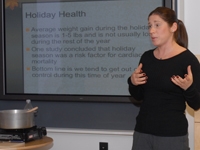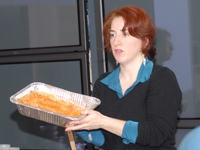
Lynn Goldstein, a dietitian at the Monahan Center, discusses tips for a healthier holiday season.
For many people watching their diet, the holidays can be a very difficult time of the year. To help prepare for the annual siege of fatty foods and sweets, Weill Cornell's Jay Monahan Center for Gastrointestinal Health hosted Lynn Goldstein, M.S., R.D., C.D.N., the center's nutritionist, and Julie Negrin, M.S., director of culinary arts at the Jewish Community Center in Manhattan, for a seminar and demonstration of healthy holiday cooking on November 14.
Although fears of gaining 10 to 15 pounds over the holidays may be slightly exaggerated (average weight gain is between one and five pounds), studies show that the holiday season has a disproportionate effect on health compared to the rest of the year. One major reason is that health changes occurring between Halloween and the Super Bowl in early January are often long lasting and not easily reversed.
"Weight gained during the holiday season is not usually lost during the rest of the year," said Goldstein.
A second reason may be a willingness to indulge ourselves, and our families, more during the holidays; according to Goldstein, the typical Thanksgiving dinner has up to 3,450 calories, even though the most recent Department of Health and Human Services Dietary Guidelines for Americans recommends between 2,000 and 3,000 for most people in an entire day. "The bottom line is that we tend to get out of control during this time of year," she said.
If you're cooking, Goldstein recommends a number of ways to provide healthier meals for your family over the holidays:
- Replace butter with unsaturated oils such as olive or canola.
- Use nonfat or reduced-fat dairy, or dairy substitutes like soy.
- Bake/broil/steam instead of frying.
- Season with herbs, spices and tangy vegetables instead of fat.
- Serve roasted vegetables, fruits and reduced fat cheeses for appetizers.
- Serve grains instead of stuffing.
- Try winter squash for an alternative to potatoes.
- Make a healthy dessert along with the cookies.
- Cut the sugar in recipes.

Julie Negrin, director of Culinary Arts at the Jewish Community Center, demonstrates a few healthful recipes to try for the holidays.
Setting goals and staying focused can help minimize any holiday weight gain, Goldstein advised. "Overeating starts during Halloween and ends with Super Bowl, but minimizing stress and staying on track can help make the new year a healthier one," she said.
Julie Negrin, M.S., the culinary arts director at the Jewish Community Center in Manhattan, also provided a healthy holiday cooking demonstration and the following recipes:
Roasted Garlic Butternut Squash Soup
- 1 head of garlic
- 1 jeweled yam
- 2 butternut squash (about 4 pounds total), halved lengthwise, seeded
- 2 tablespoons vegetable oil
- 2 tablespoons butter
- 3 yellow onions, thinly sliced
- 4 cups vegetable stock or butternut squash soup by Imagine
- 3 cups water
- ½ teaspoon cinnamon
- ¼ teaspoon ground ginger
- Salt & pepper to taste
- 8 oz. whole milk plain yogurt
- 1 bunch chives, diced
Preheat oven to 375°F. Cut top ¼ inch off heads of garlic to expose cloves and generously pierce yam. Place squash, cut side down, on foiled baking sheet alongside garlic and yam. Bake until garlic, yam and squash are very soft, about 1 hour.
While vegetables are roasting, heat butter in dutch oven or stockpot and add onions. Caramelize onions over low heat for at least 30 minutes. When vegetables are done roasting, scoop the flesh out of each and add to onions. Add broth, water and spices and bring to a boil. Reduce heat to medium-low, cover and simmer for at least 20 minutes (or up to 2 hours).
Just prior to puréeing soup, add yogurt. Purée in either a blender or food processor, or use an immersion blender. (Can be prepared 1 day ahead. Cool slightly. Cover and refrigerate.) Ladle into bowls. Sprinkle with chives and serve.
Serves 8
Preparation time: 1 ½ hours
Recipe by Julie Negrin
Marbleized Root Vegetable Puree
Root vegetables became a mainstay of the New England diet. The crops grew well during the summer and could be stored in barrels of sand or in root cellars to keep through the long winter. This spectacular casserole has potatoes, parsnips, turnips and carrots, and is sweetened with just a hint of pear. The pureed vegetables are swirled together in the baking dish to create a pretty marbled effect.
- 2 pounds russet potatoes (about 3 large), peeled, cut into 2-inch pieces
- 8 ounces turnips (about 2 medium), peeled, cut into 2-inch pieces
- 8 ounces parsnips, peeled, cut into 1-inch pieces
- 1 medium pear (about 6 ounces), peeled, cored, cut into 1-inch pieces
- ½ cup whipping cream, soy milk or non-dairy creamer
- 8 tablespoons (1 stick) butter or nonhydrogenated margarine (such as Earth Balance)
- 1 ½ pounds carrots (about 6 large), peeled, cut into 1-inch pieces
- 1/8 teaspoon ground nutmeg
- Additional ground nutmeg
Preheat oven to 350°F. Butter 2-quart baking dish. Cook potatoes, turnips, parsnips and pear in large pot of boiling salted water until very tender, about 20 minutes. Drain. Return to pot. Stir over low heat until excess moisture evaporates, about 1 minute. Add cream and 5 tablespoons butter and mash until smooth. Season with salt and pepper.
Meanwhile, cook carrots in another large pot of boiling salted water until tender, about 15 minutes. Drain. Transfer to processor. Add 2 tablespoons butter and 1/8 teaspoon nutmeg and puree until smooth. Season with salt and pepper.
Alternate potato and carrot purees by ½ cupfuls in baking dish. Draw knife through purees to marbleize. Melt 1 tablespoon butter. Drizzle over purees. Sprinkle with additional nutmeg. Cover with foil. (Can be made 1 day ahead; chill.) Bake covered puree until heated through, about 35 minutes (or 45 minutes if chilled).
Serves 10
Source: Bon Appétit, November 1996
Quinoa Stuffing with Sautéed Zucchini
A healthier Thanksgiving dish your guests will gobble up. Quinoa, an ancient grain eaten by the Incas, is high in protein, calcium and iron.
Stuffing
- 2 cups quinoa
- 4 cups water
- 1-2 tablespoons olive oil
- 1 onion, sliced
- 2 small zucchini, cut into 1-inch cubes
- ½ cup pine nuts, toasted
- ¼ cup fresh parsley, chopped
- 1 teaspoon of orange zest
Dressing
- 4 tablespoons white wine vinegar
- 1/3 cup olive oil
- 4 tablespoons mirin
- 2 tablespoons Dijon mustard
- 2 teaspoons garlic, finely minced
- Juice of 1 lemon
Start with caramelizing onions by heating olive oil in large skillet and adding onions. Cook on low heat for at least 30 minutes. Stir every few minutes. Add sliced zucchini and cook for 10 more minutes or until tender.
Rinse quinoa in fine-meshed strainer. Bring water and quinoa to a boil in a large saucepan. Turn down heat, cover and simmer for 15–20 minutes or until there is no water in the bottom of the pan. Do not stir. Simply slide a knife down the side of the pan and push quinoa aside to see if there is any water on bottom of pan.
Whisk dressing ingredients together. Toss quinoa with dressing serving bowl. Add onions, zucchini, squash, nuts, parsley and zest. Serve warm or at room temperature.
Serves 6
Preparation time: 45 minutes
Recipe by Julie Negrin
For more seminar information and recipes, visit the Monahan Center Web site at www.monahancenter.org/nutrition.
Photos by Weill Cornell Art & Photography.

